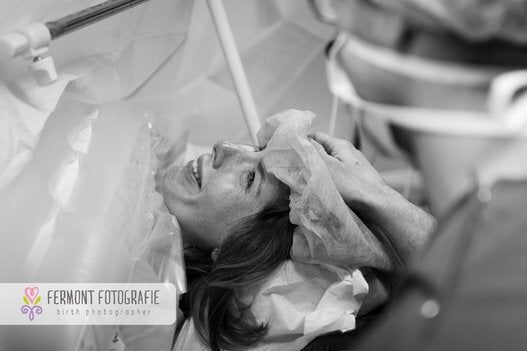When Quinn was born in January, she seemed like a perfectly healthy baby.
But when she was a few weeks old, she caught a cold and didn't recover.
Parents Robert Shirley and Dawn Roberts took Quinn to the hospital in their hometown of Victoria, B.C. There, the baby was subject to a slew of tests.
"Our doctor at the time had this funny feeling, thinking something wasn't right with her," Robert said.

Quinn and her mom, Dawn Roberts. (Photo: Robert Shirley)
Blood tests helped doctors figure out that Quinn had a rare genetic disorder called adenosine deaminase–deficient severe combined immunodeficiency, known as ADA-SCID, or SCID.
Because of the condition, Quinn's immune system doesn't work as it should. Any infection — be it a serious virus or a bout with the common cold — could kill her.

Quinn. (Photo: Robert Shirley)
"She produces all the white blood cells she needs to fight infection, but when her body reproduces those cells, the old cells that her body leaves behind aren't being filtered out," Robert explained in an interview with The Huffington Post B.C. "So when those old cells break down, they produce a toxin that's killing some of her new white blood cells that she needs.
"As soon as you get exposed to germs, [patients] don't have the immune system to fight it off. Her body doesn't react to seeing a cold — it'll just let the virus do its thing. She won't get fevers or anything like that," he added.
"Babies that have SCID, a lot of them don't make it to the hospital because parents just don't know they're sick," Dawn added. "So it was actually a blessing that she happened to catch that bug."
'Bubble babies'
No SCID case is better known than David Vetter's. Born in Houston in 1971, Vetter spent his entire life — save two weeks — inside what was essentially a big, plastic balloon.
It was a sterile space that acted as a barrier between life and death.
He became known as "the boy in the bubble," living inside the plastic walls until he died at the age of 12.
Vetter was a phenomenon, because back then, babies with SCID just didn't live as long as he had.
Most didn't even come close.
Nowadays, children like Quinn — commonly known as "bubble babies" — have treatment options.
The first is a bone marrow transplant. Robert and Dawn are testing to see if they're a match, although it's not likely. A sibling would be a better candidate, but Quinn doesn't have any.
The second option, if a transplant is ruled out, would be an experimental gene therapy treatment available at the University of California in Los Angeles (UCLA).
Doctors would extract one of Quinn's defective cells, repair it, and then put it back in the baby's body. That cell would then reproduce, slowly building a functioning immune system.
If successful, Robert and Dawn say Quinn would have a chance at a "normal" life.
"We've have an amazing medical team working with us to get Quinn and get her on the right path," Robert said.

Newborn Quinn with her parents before being diagnosed with ADA-SCIDS. (Photo: Painted Barn Photography)
As of November 2014, 18 children with SCID had been cured through treatment at UCLA.
One Toronto boy that underwent the procedure is "well on his way" to recovery, and Dawn said she's in touch with his mom to chat about what happens next.
Doctors from Vancouver General Hospital have applied to see whether Quinn is eligible for the treatment, but haven't heard back.
Costly cures
Quinn's parents face heavy costs, no matter which route they take.
If the baby undergoes a bone marrow transplant, Dawn and Robert will have to cover the cost of living in Vancouver, prepping their home for long-term recovery, and their daughter's post-op medication.
If they go for gene therapy, the family will likely have to cover travel costs to California. On top of that, it's not clear whether the experimental U.S. treatment will be covered by B.C.'s Medical Services Plan.
Robert and Dawn say they're not sure how much they'll have to shell out for treatment at UCLA, but they're certain it won't be cheap.
With both options, the couple would leave their jobs to care for Quinn in her own "bubble" while she recovers.
The process could take several years.
"It’s been quite a process ... But we’re willing to do anything to keep her healthy."
In March, Quinn's extended family launched a GoFundMe campaign to pay for the anticipated bills.
They've raised nearly $20,000 — a number Dawn said is overwhelming.
Quinn is currently in hospital, fighting off an unrelated problem with her bowels. When she's able to eat properly again, her parents will be able to bring her home while they wait for a decision on a treatment for her condition.
While they wait, the family will have strict rules to follow.

Robert Shirley, Dawn Roberts, and baby Quinn. (Photo: Robert Shirley)
"We'll be sent home to live in isolation," Dawn said. "No visitors ... our dog won't be allowed in the same room ... and I'm not able to breastfeed, because I could catch a cold and pass it onto her."
"It's been quite a process ... But we're willing to do anything to keep her healthy," the first-time mom added.
"What we just have to do is stay positive for Quinn. She's been extremely strong, and she's been through a lot for only two months on the planet."



Follow Us On Instagram
Also On HuffPost:
